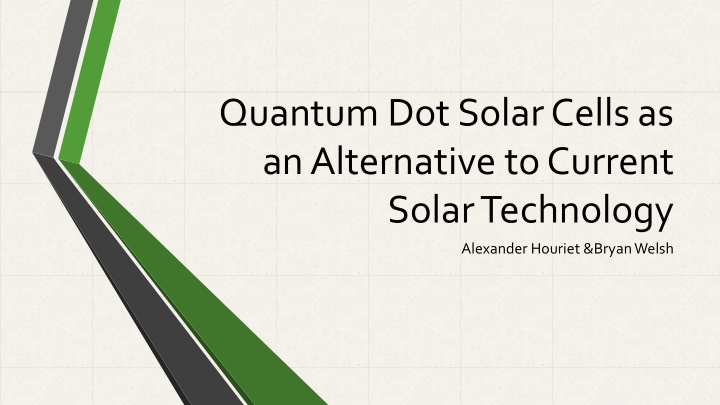



Quantum Dot Solar Cells as an Alternative to Current Solar Technology Alexander Houriet &Bryan Welsh
Current Solar Technology • Silicon solar cells • Dye-sensitized solar cells • Maximum efficiency: 22%
Quantum Dots • Microscopic semiconductors • Incredibly photosensitive • Commonly used in LCD screens
Theoretical Capabilities • Different production processes yield different results • Each has its own unique strengths and weaknesses. • Maximum theoretical efficiency: 70.42% • Maximum tested efficiency: ~9%
Band Alignment Engineering • Involves tuning distance between dots • Changing materials between dots • Real efficiency: 8.55% • Most durable cell • Lasts over 150 days
Usage of Intermediate Bands • Addition of more bands between cells • Shortens energy gap • Super lattice structure • Theoretical efficiency: 70.42%
CuS Nano Peas as a counter Electrode • Nano peas used to assist in charge transfer • Applied as a film coating • Theoretical efficiency:65% • Real efficiency: 4%
Type II Quantum Dots • Cell composition optimization • Better voltage outputs • Lower current density • Theoretical efficiency: 63.2%
Environment and Ethics • Technologies to consider • QDSC’s • Nuclear Power • Fossil Fuels • QDSC’s • Take up less space than current solar cells • More efficient solar farms
Nuclear • Safety Costs • Concern of Meltdown • Radioactive waste production • Location Flexibility
Fossil Fuels • Carbon emissions and the environment • Finite resources • Established infrastructure • Costs of converting to new sources
Sustainability • High potential for efficiently powering society • Green capabilities • Clean • Job creation
Our Endorsement of a Solution • Strength in diversity • Benefits far outweigh detriments • Potentially a key factor in alleviating the energy crisis • Waste-reducing alternative
Recommend
More recommend